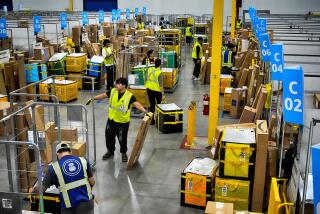Productivity Rate Makes a Feeble Gain
WASHINGTON — The nation’s manufacturing productivity improved at an anemic 1.4% annual rate in the third quarter, with output gains at a three-year low and unit labor costs rising at the fastest rate since the 1982 recession, the Labor Department said Thursday.
The department said overall productivity in the non-farm sector of the economy was up at an annual rate of 2.1% in the July-September period, nearly double the revised 1.1% annual rate gain posted in the second quarter.
But that improvement was overshadowed by other data in the report suggesting that the manufacturing slump is far from over and that wage inflation remains stubborn despite a recent moderation in consumer price increases.
“Manufacturing is clearly soft,” said David Wyss of the DRI-McGraw Hill forecasting firm. “The economy is slowing down, and that is going to be felt disproportionately by manufacturing.”
Added Merrill Lynch’s Donald Straszheim: “Manufacturing is not likely to improve much until well into next year.”
The 1.4% annual rate gain in manufacturing productivity in the third quarter was off dramatically from the revised second-quarter improvement of 3.7%. The third-quarter number represented the smallest productivity increase since the fourth quarter of 1987.
Output in manufacturing was up just 1.3% at an annual rate in the third quarter--its smallest gain since 1986--and hours worked in American factories declined 0.1% at an annual rate after falling a revised 0.2% in the second quarter.
September unemployment data showed a 103,000 drop in manufacturing employment, a sign to analysts that manufacturers were trying to cut costs and boost productivity.
But the outlook remains bleak for the next several months, the analysts said, because rising unit labor costs will exacerbate the already unfavorable position most U.S. manufacturers find themselves in in world markets.
Indeed, the Labor Department said unit labor costs rose at a rapid 4.5% annual rate in the third quarter after falling at a revised annual rate of 1% in the second quarter. It was the largest quarterly increase in unit labor costs in manufacturing since a 9.7% annual gain in the first quarter of 1982.
The overall numbers for the non-farm sector were somewhat more encouraging but still underscored the recent economic slowdown and the persistent upward pressure on wages.
The 2.1% annual-rate non-farm productivity gain resulted from a 3.1% rise in output and just a 1% gain in hours worked. The increase in hours worked was the lowest in more than three years.
Hourly compensation in the entire non-farm sector rose at an annual rate of 5.3% in the non-farm sector, down from the second quarter annual-rate gain of 5.6% but still evidence of underlying inflationary pressures.
“Inflation is still a very serious problem,” said Elliott Platt, a senior vice president at Donaldson, Lufkin & Jenrette.
The productivity gain helped offset the impact of wage gains on unit labor costs in the overall non-farm sector. They increased at an annual rate of 3.2% in the third quarter after rising at a revised 4.5% in the second quarter.
More to Read
Inside the business of entertainment
The Wide Shot brings you news, analysis and insights on everything from streaming wars to production — and what it all means for the future.
You may occasionally receive promotional content from the Los Angeles Times.










